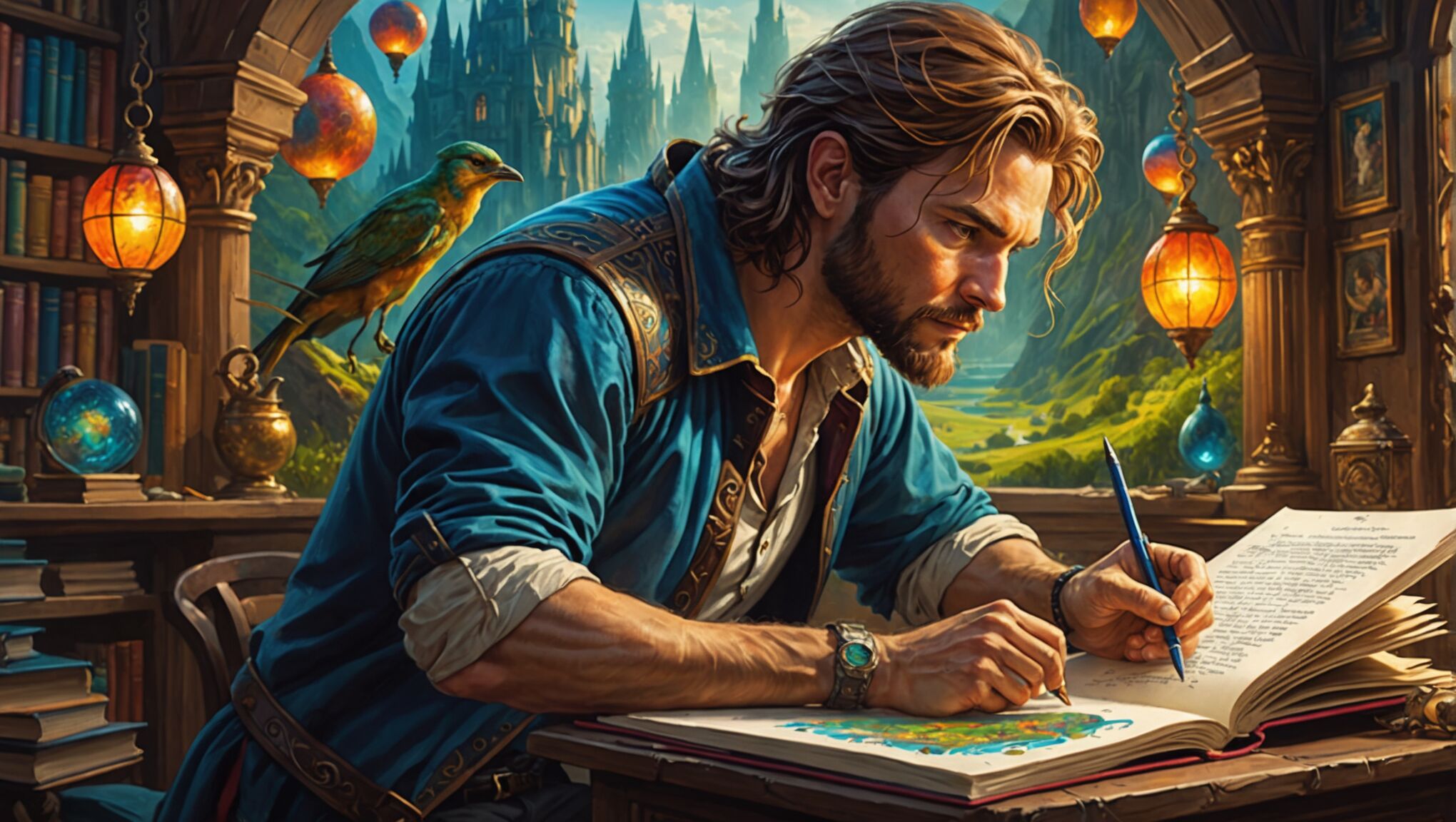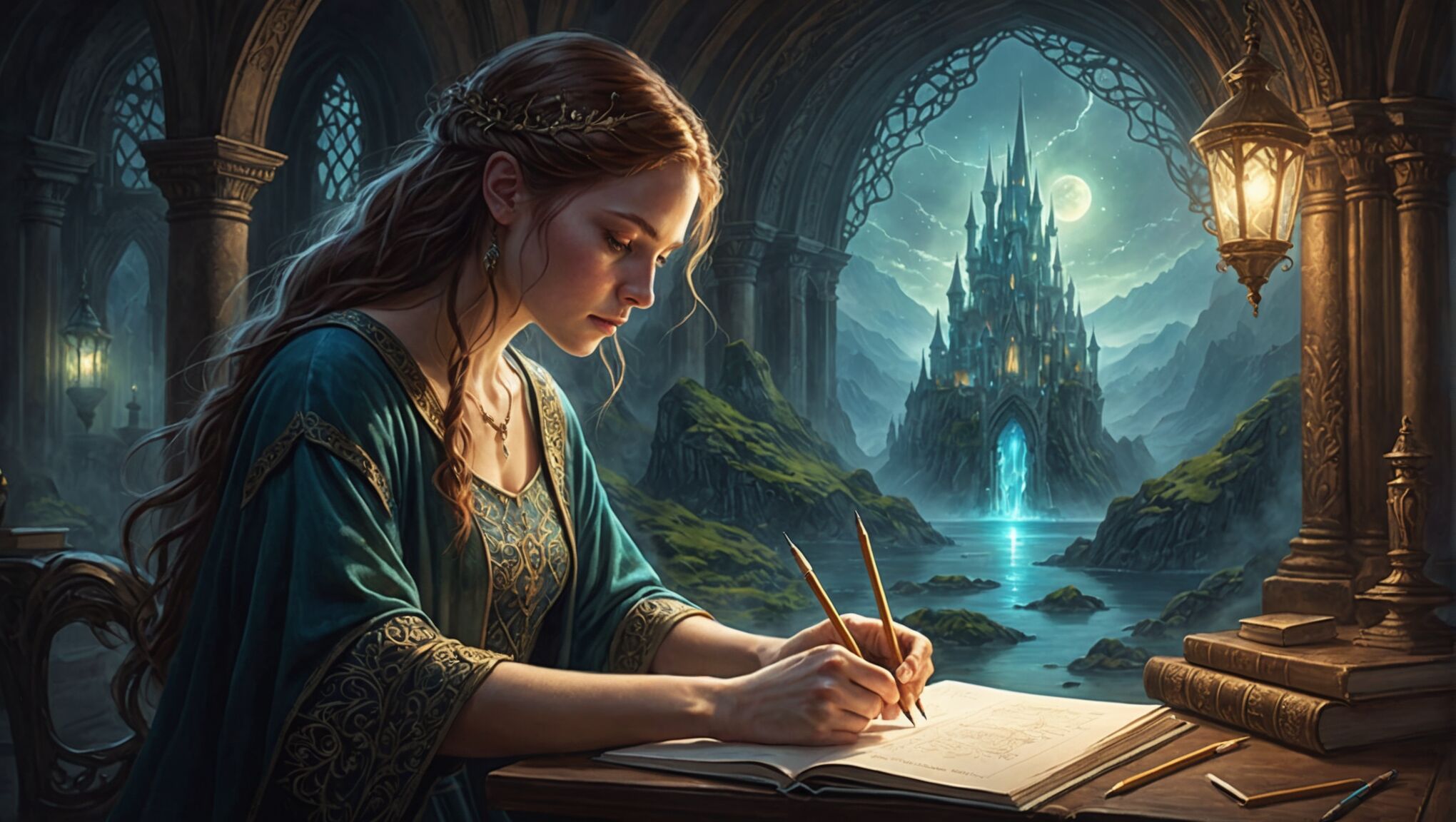blog
How to Choose the Right Illustrator for Your Fantasy Cover
Fantasy cover illustrations come in a wide range of styles, each with its own unique appeal and audience. Traditional fantasy art often features highly detailed, realistic depictions of mythical creatures, heroes, and magical landscapes. This style, popularized by artists like Frank Frazetta and Boris Vallejo, can create a sense of epic grandeur and immersion. On the other hand, more stylized or abstract approaches can evoke a sense of mystery and otherworldliness, appealing to readers who prefer a less literal interpretation of the story. Digital art has opened up new possibilities, allowing for seamless blending of photorealistic elements with fantastical imagery.
When considering styles, it’s essential to think about your target audience and the tone of your book. A gritty, dark fantasy might benefit from a more muted color palette and shadowy figures, while a whimsical tale could shine with bright colors and exaggerated proportions. Character-focused covers can draw readers in with emotive portraits, while scenic illustrations can set the stage for the adventure within. Some popular sub-styles include steampunk, which blends Victorian aesthetics with futuristic elements, and urban fantasy, which often features modern cityscapes infused with magical elements.
It’s also worth considering the current trends in fantasy cover art. While you don’t want to simply copy what’s popular, being aware of market preferences can help your book stand out on shelves or in online stores. Look at bestselling books in your specific fantasy sub-genre to get a sense of what readers are drawn to. Remember that your cover is not just art – it’s a marketing tool that should accurately represent your story while capturing the imagination of potential readers.
Evaluating an illustrator’s portfolio
 When evaluating an illustrator’s portfolio, it’s crucial to look beyond the surface appeal and assess whether their work aligns with your vision and book’s requirements. Start by examining the range of their work. A diverse portfolio demonstrates versatility, which can be valuable if you’re looking for a unique style or blend of elements for your cover.
When evaluating an illustrator’s portfolio, it’s crucial to look beyond the surface appeal and assess whether their work aligns with your vision and book’s requirements. Start by examining the range of their work. A diverse portfolio demonstrates versatility, which can be valuable if you’re looking for a unique style or blend of elements for your cover.
Pay close attention to the illustrator’s ability to capture emotion and atmosphere. Fantasy covers often need to convey complex feelings and settings at a glance. Look for pieces that evoke the mood you want for your book. Are their characters expressive? Do their landscapes feel immersive?
Technical skill is paramount. Analyze the quality of their linework, color theory application, composition, and overall execution. Even if an artist’s style is intentionally simplistic, there should be evidence of strong foundational skills.
Consider the artist’s experience with book covers specifically. Cover illustration requires a different approach than standalone art pieces. The composition needs to work with title placement and should be impactful even when viewed as a thumbnail online.
“The cover is a visual haiku of the story,” says Chip Kidd, renowned book cover designer. This encapsulates the importance of finding an illustrator who can distill your narrative into a single, powerful image.
Look for consistency in quality across the portfolio. While it’s normal for artists to experiment and evolve, you want to ensure they can reliably produce work at the level you need.
Don’t overlook the artist’s ability to handle different subjects relevant to your book. If your story features dragons, check if they have experience drawing convincing mythical creatures. If your setting is a magical forest, look for examples of intricate natural scenes in their portfolio.
Lastly, consider how their style fits with current market trends while still offering something unique. You want a cover that will appeal to your target audience but also stand out among similar books. An illustrator with a fresh perspective can help your book catch the eye of potential readers.
Remember, a portfolio is more than just a collection of pretty pictures. It’s a showcase of an artist’s problem-solving skills, creativity, and ability to meet client needs. Take the time to thoroughly review each potential illustrator’s body of work to ensure you find the perfect match for your fantasy cover.
Determining your budget and timeline

Before embarking on your search for the perfect illustrator, it’s crucial to establish a clear budget and timeline for your project. Your budget will significantly influence the caliber of artists you can approach and the level of detail you can expect in the final artwork. Professional fantasy cover illustrators typically charge anywhere from $500 to $5,000 or more, depending on their experience, reputation, and the complexity of the project.
Consider factors such as the illustrator’s hourly rate, the estimated time required for the project, and any additional costs like revisions or licensing fees. It’s wise to allocate a portion of your overall book production budget specifically for cover art, as a high-quality cover can significantly impact your book’s marketability.
Regarding timeline, be realistic about your publishing schedule and communicate this clearly to potential illustrators. Most professional artists require several weeks to months to complete a commission, depending on their current workload and the intricacy of the piece. Factor in time for initial consultations, sketches, revisions, and final touches. Remember that rushing an artist may compromise the quality of the work, so it’s better to start the process early.
Be prepared to provide a detailed brief to potential illustrators, including your budget range and desired completion date. This transparency will help you attract artists who are available and willing to work within your constraints. Keep in mind that some illustrators may have waiting lists, so if you have a specific artist in mind, reach out well in advance of your intended publication date.
If your budget is limited, consider exploring options such as up-and-coming artists who may offer more competitive rates, or look into pre-made cover art options. However, weigh these choices carefully against the potential impact a custom, high-quality cover can have on your book’s success.
Ultimately, finding the right balance between your budget, timeline, and desired quality is key. Be prepared to adjust your expectations or allocate additional resources if necessary to achieve the cover art that will best serve your fantasy novel. Remember, your cover is often the first point of contact between your book and potential readers, making it a crucial investment in your work’s future success.
Communicating your vision effectively
When conveying your vision to an illustrator, clarity and specificity are paramount. Start by creating a comprehensive brief that outlines the key elements you want to see in your cover. Include details about the main characters, their appearance, the setting, and any symbolic or thematic elements that are crucial to your story. Provide references to existing artwork or book covers that inspire you, but be clear about what aspects you appreciate and why.
Visual mood boards can be incredibly helpful in communicating the atmosphere and style you’re aiming for. Collect images that represent the color palette, textures, and overall feel you envision for your cover. This can include photographs, paintings, or even fabric swatches that evoke the right mood.
Be specific about technical requirements as well. Provide the exact dimensions for the cover, including spine width if applicable, and any specifications for print or digital formats. Discuss where the title, author name, and any additional text will be placed, as this will impact the overall composition.
When describing your vision, use concrete terms rather than abstract concepts. Instead of saying “make it look magical,” describe the elements that convey magic to you, such as “swirling mists with glowing particles” or “ancient runes etched in stone, emanating a soft light.”
Consider creating a simple sketch or diagram to illustrate your ideas, even if you’re not artistically inclined. This can help convey layout preferences and the hierarchy of elements on the cover.
Provide context about your target audience and the book’s genre. This information helps the illustrator understand the market expectations and tailor their approach accordingly.
Find the perfect illustrator for your fantasy cover. Click here to learn more.
Be open to the illustrator’s input and expertise. While it’s important to communicate your vision clearly, remember that you’ve chosen this professional for their skills and creative perspective. They may have valuable suggestions that could enhance your initial concept.
Use the following table to organize key information for your illustrator:
| Element | Description |
| Main Character | Age, appearance, distinctive features, typical attire |
| Setting | Time period, landscape, key landmarks or structures |
| Color Palette | Preferred colors, mood (e.g., dark and moody, bright and vibrant) |
| Symbolism | Important objects, creatures, or elements that represent themes in your book |
| Style References | Links or descriptions of artwork that inspire your vision |
Throughout the process, maintain open lines of communication. Be available to answer questions and provide feedback promptly. Remember that creating a cover is a collaborative process, and clear, respectful communication will help ensure the final product aligns with your vision while benefiting from the illustrator’s artistic expertise.
Reviewing an illustrator’s work process
 Before embarking on a collaboration with an illustrator, it’s crucial to understand their work process. This knowledge will help you set realistic expectations and ensure a smooth partnership. Start by asking about their typical workflow, from initial concept to final delivery. Most illustrators follow a structured approach that includes stages such as thumbnail sketches, rough drafts, color studies, and final rendering.
Before embarking on a collaboration with an illustrator, it’s crucial to understand their work process. This knowledge will help you set realistic expectations and ensure a smooth partnership. Start by asking about their typical workflow, from initial concept to final delivery. Most illustrators follow a structured approach that includes stages such as thumbnail sketches, rough drafts, color studies, and final rendering.
Inquire about their preferred method of receiving feedback and how many rounds of revisions are included in their standard package. Some artists may offer unlimited revisions, while others might specify a set number. Understanding this upfront can help avoid misunderstandings later in the process.
It’s also important to discuss their timeline for each stage of the project. Ask how long they typically spend on sketches, how much time they allocate for revisions, and what their expected turnaround time is for the final piece. This information will help you plan your publishing schedule more effectively.
Consider the artist’s tools and techniques. Do they work digitally, traditionally, or use a combination of both? This can affect not only the final look of your cover but also the flexibility for changes and the delivery format of the artwork.
Discuss their approach to research and reference gathering. A thorough illustrator will often request additional information about your story, characters, and setting to ensure accuracy in their depictions. Their willingness to delve into these details can be a good indicator of their commitment to capturing your vision.
Ask about their process for handling unexpected challenges or creative blocks. A professional illustrator should have strategies in place to overcome obstacles without significantly impacting the project timeline.
It’s also worth inquiring about their collaboration style. Some illustrators prefer to work independently with minimal input until they present a near-final draft, while others may seek feedback at various stages. Determine which approach aligns best with your preferences and needs.
Lastly, don’t forget to ask about their policy on modifications after the project is complete. While it’s best to address all changes during the revision stages, knowing their stance on post-completion alterations can be helpful.
By thoroughly understanding an illustrator’s work process, you’ll be better equipped to make an informed decision and set the stage for a successful collaboration. Remember, the goal is to find an artist whose process not only produces stunning results but also complements your working style and project requirements.
Finalizing contract and copyright agreements

Once you’ve found the perfect illustrator for your fantasy cover, it’s crucial to formalize the agreement with a comprehensive contract. This document should outline all aspects of the project, including the scope of work, payment terms, deadlines, and copyright ownership. Begin by clearly defining the deliverables, such as the number of concept sketches, revisions, and the final high-resolution artwork.
Payment terms should be explicitly stated, including the total fee, any deposit required, and the schedule for subsequent payments. Many illustrators work on a milestone basis, with payments tied to specific stages of completion. Be sure to discuss and include any additional costs, such as rush fees or extra revisions beyond the agreed-upon number.
Copyright is a critical aspect of the agreement. Typically, the illustrator retains the copyright to the artwork, while you, as the client, purchase the right to use the image for your book cover. Specify the extent of usage rights you’re acquiring – for instance, whether you can use the artwork for promotional materials, merchandise, or future editions of the book. If you require full copyright ownership, be prepared to negotiate a higher fee, as this is not standard practice and significantly impacts the illustrator’s ability to profit from the work in the future.
Include clauses that address potential scenarios such as project cancellation, delays, or the need for significant changes after approval of the final artwork. These clauses protect both parties and set clear expectations for how to handle unforeseen circumstances.
Confidentiality may also be an important consideration, especially if your book concept contains unique elements you wish to protect. A non-disclosure agreement can be incorporated into the contract or added as a separate document.
Consider adding a clause about crediting the illustrator. Many artists appreciate having their name mentioned on the book or in promotional materials, which can be a win-win situation, providing them with exposure while adding credibility to your project.
If you’re unsure about any legal aspects of the contract, it’s wise to consult with a lawyer who specializes in intellectual property or entertainment law. They can help ensure that the agreement is fair and protects your interests adequately.
Remember that a well-crafted contract is not just about protection; it’s a tool for clear communication. It helps prevent misunderstandings and sets the foundation for a positive working relationship with your illustrator. By taking the time to address these details upfront, you’re paving the way for a smooth collaboration and a stunning fantasy cover that will captivate readers and do justice to your story.

